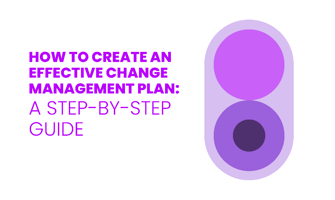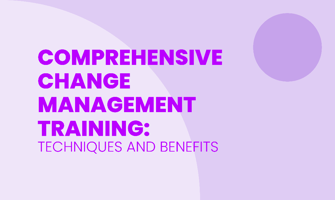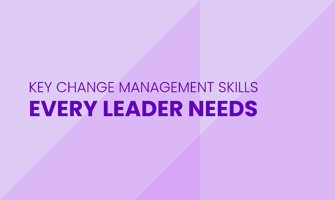Change is inevitable in any business environment. With a well-structured change management plan,...
Understanding the Change Management Process: Steps and Best Practices
A change management process is a structured approach to moving an organization from its current state to a desired future state. It involves preparing for change, managing the implementation process, and reinforcing new behaviors.
Without a change management process, organizations risk falling behind their competitors or even becoming obsolete. Those who manage change well are more likely to stay relevant and thrive in today’s dynamic business environment.
In this article we'll explore the change management process, outlining its steps and sharing some best practices for implementation as well as valuable insights on how to successfully implement organizational change.
What is the Change Management Process?
Change management refers to a systematic approach that helps organizations deal with significant shifts or transitions. To stay competitive, organizations have to keep up with changes in market trends, customer preferences, and new technologies. 79.7% of businesses need to adapt to change every two to five years to survive.
The process of change management revolves around three main components: people, processes, and technology:
People: The individuals who will be affected by the transition need to understand why it’s happening and what their role will be during this period.
Processes: These are steps or actions taken to ensure the smooth execution of changes within an organization.
Technology: This includes any tools or systems used to facilitate the implementation of changes.
Understanding these elements thoroughly can help businesses navigate changes more efficiently while minimizing disruptions.
![]()
Steps in the Change Management Process
1. Assess Organizational Readiness
Evaluating how ready your organization is for change involves several steps to identify potential obstacles and plan strategies to address them:
Surveys: Use online survey tools to collect employee feedback. These tools help you understand how employees feel about the proposed changes. By knowing their concerns, you can address them early and reduce resistance.
Interviews with key stakeholders: Conduct detailed interviews using structured guides and recording devices to capture feedback. These interviews provide deeper insights into potential issues and concerns. Stakeholders often have valuable perspectives that can help highlight challenges and opportunities.
Organizational readiness assessment: Perform a comprehensive evaluation of your organization’s culture, resources, and capabilities using diagnostic tools. This helps you identify strengths and weaknesses, allowing you to create a tailored change strategy. Understanding your current state helps plan the resources and support needed for a smoother transition.
2. Define Clear Objectives and Goals
Setting clear objectives and goals is important for guiding your change initiative. This process involves creating specific, measurable targets that provide direction and align everyone involved:
Project Management Software: Use project management tools to define, assign, and monitor tasks and objectives. These tools help set clear milestones and timelines, keeping the project on track. Everyone knows their responsibilities and deadlines, improving accountability and efficiency.
Data Analytics: Implement data analytics to monitor key performance indicators (KPIs) related to your change goals. Real-time tracking allows for timely adjustments and informed decisions. Data-driven insights help you measure progress accurately and make adjustments as needed.
Collaborative Platforms: Use collaborative platforms to facilitate communication and teamwork. These platforms ensure everyone is aligned and working towards the same objectives. Effective communication and collaboration are essential for successful change management, keeping all team members informed and engaged.
By setting specific, measurable, and time-bound goals and using modern tools and technology, you can streamline the change process and increase the chances of achieving your desired outcomes. Tools like 180ops provide comprehensive solutions for managing and integrating data efficiently, empowering organizations to make informed decisions during change initiatives.
3. Develop a Comprehensive Change Management Plan
A comprehensive change management plan serves as a detailed roadmap for your change initiative, specifying who is involved, what actions are needed, when tasks should be completed, and how the process will unfold.
Project Management Tools: Outline tasks, assign responsibilities, and set timelines to ensure all aspects of the plan are covered. This helps keep everyone on track and ensures clarity.
Flowcharts and Diagrams: Use visual aids like flowcharts and diagrams to map out the change process. These visuals can simplify complex processes, making it easier for everyone to understand their roles and responsibilities.
Checklists: Create checklists for each phase of the change process to ensure that no steps are overlooked. These can serve as quick reference points for team members, helping them stay organized and focused.
4. Communicate the Change Vision and Strategy
Effectively communicating the change vision and strategy is important to ensure everyone involved understands the objectives, importance, and process of the change.
Workshops and Training Sessions: Conduct workshops and training sessions to educate employees about the change. These sessions provide an interactive platform for employees to ask questions and gain a deeper understanding of the change vision.
Internal Newsletters: Use internal newsletters to provide regular updates and keep everyone informed about the progress of the change initiative. Newsletters can highlight key milestones, address common concerns, and share success stories to keep morale high.
Feedback Mechanisms: Establish channels for receiving and addressing employee feedback. This can include suggestion boxes, regular Q&A sessions, or digital platforms where employees can voice their concerns and suggestions.
Effective communication helps reduce fear and resistance to change, ensuring everyone is on the same page and supportive of the initiative. Tailor your communication methods to fit your organizational culture, ensuring clarity and understanding for all employees.
![]()
5. Empower and Equip Change Leaders
Empowering and equipping change leaders is crucial for the success of your change initiative. These individuals guide your organization through the transition and ensure everyone stays on track.
Specialized Training: Offer leadership training tailored to managing change. This could include workshops on communication strategies during uncertain times and techniques for motivating teams when morale is low. For example, training sessions might cover conflict resolution and maintaining team cohesion.
Mentoring Programs: Pair less experienced change leaders with those who have successfully navigated transitions before. This hands-on learning builds confidence and equips leaders with practical skills. Experienced leaders can share their strategies for overcoming common obstacles, offering invaluable insights.
Leadership Simulations: Use simulation software to create realistic scenarios where change leaders can practice their skills in a controlled environment. This helps them prepare for real-life challenges.
Peer Support Groups: Establish support groups where change leaders can share experiences and advice. These groups provide a platform for discussing challenges and solutions, fostering a collaborative approach to change management.
6. Implement the Change Incrementally
Implementing change incrementally involves introducing changes in small, manageable stages. This approach helps make the process more manageable and less overwhelming.
Pilot Programs: Test parts of the change with a small group before rolling it out across the entire organization. This allows you to identify and address potential issues on a smaller scale, making necessary adjustments before full implementation. For instance, a new software system might first be tested in one department to gather feedback and make improvements.
Phased Rollouts: Implement different parts of the change at different times according to a set schedule. This method helps teams gradually adapt to new processes, reducing resistance and increasing acceptance. For example, a new organizational structure could be introduced one division at a time, allowing for adjustments based on initial feedback.
Agile Methodology: Apply agile principles to manage change incrementally. Break down the change into small, iterative steps, allowing for continuous feedback and improvement.
Sandbox Environments: Create sandbox environments where new systems or processes can be tested in a controlled setting without affecting daily operations. This allows for safe experimentation and learning.
7. Monitor Progress and Adjust as Needed
Monitoring progress is essential to ensure your change initiative stays on track. Regular checks help you measure success and make necessary adjustments.
Key Performance Indicators (KPIs): Use measurable values to track how well your organization is achieving its change objectives. For example, if your goal is to improve customer satisfaction, a relevant KPI could be the percentage of positive customer feedback.
Dashboards: Utilize visual tools that display important information in real-time, enabling quick decision-making. Dashboards can show progress on various metrics, providing a clear overview of how the change is progressing.
Feedback Loops: Regularly collect feedback from stakeholders, such as employees and customers, to understand their perspectives and identify areas for improvement. Analyzing this feedback allows you to make data-driven adjustments. For example, employee surveys can reveal how well they are adapting to the new processes and highlight any concerns that need addressing.
Progress Reviews: Conduct regular progress reviews with your team to discuss what’s working and what’s not. This encourages continuous improvement and keeps the project aligned with its goals.
Automated Monitoring Tools: Use automated tools to track progress and send alerts if certain metrics deviate from the plan. This ensures timely interventions and keeps the project on track.
8. Sustain and Embed the Change
Sustaining and embedding change ensures that new processes, behaviors, or systems become a permanent part of your organization’s operations.
Continuous Training: Provide ongoing training to keep everyone up-to-date with new ways of doing things and reinforce their importance. This can include refresher courses and advanced training sessions to ensure skills and knowledge remain current.
Reinforcement Programs: Regularly remind employees of why the changes were made and encourage them to continue following new procedures. For instance, periodic meetings or newsletters can highlight the benefits achieved through the change and recognize employees who are effectively embracing the new practices.
Change Champions: Identify and empower change champions within your organization who can advocate for the new processes and help others adapt. These individuals can provide support and encouragement to their peers.
Recognition and Rewards: Implement a recognition and rewards program to acknowledge employees who excel in adapting to and promoting the change. This can motivate others to follow suit and maintain the new behaviors.
Performance Metrics: Continuously monitor performance metrics to ensure the change is producing the desired results. Use this data to make any necessary adjustments and reinforce successful practices.
Best Practices for Change Management
1. Engage and Communicate with Stakeholders
Involving stakeholders actively in the change process ensures they feel valued and are more likely to support the changes.
Conduct focus groups to gather detailed insights from various stakeholders, allowing for in-depth discussions that reveal concerns and suggestions. Use stakeholder mapping to identify and prioritize key individuals and groups affected by the change, ensuring targeted and effective communication efforts.
2. Offer Continuous Training and Development
Provide ongoing training to equip your team with the necessary skills to adapt to new processes or systems, ensuring smooth transitions. Implement microlearning modules that deliver information in small, manageable chunks, enhancing retention and making training less overwhelming.
Also, offer interactive e-learning courses that employees can complete at their own pace, ensuring they understand how the changes affect their roles and responsibilities.
3. Identify and Mitigate Resistance Proactively
Effectively managing resistance involves understanding why employees might resist change and addressing it early. Conduct change readiness assessments to evaluate how prepared the organization is for the change, identifying potential resistance points.
Develop resistance management plans that include targeted communication strategies, additional training sessions, and involving resistant individuals in the planning process to make them feel more invested in the outcome.
4. Leverage Data and Analytics for Decision-Making
Utilize data and analytics to gain insights into the change process and make informed decisions. Implement sentiment analysis tools to gauge employee morale and reactions to change initiatives, providing real-time feedback on how changes are being received.
Use performance dashboards to track progress against key metrics, allowing you to quickly identify and address any issues that arise during the implementation.
5. Conduct Post-Implementation Reviews and Learn from Feedback
After implementing changes, evaluate their success and identify areas for improvement. Conduct lessons learned workshops to gather insights on what worked well and what could be improved, fostering a culture of continuous improvement.
Regularly review key performance indicators (KPIs) to ensure the changes have achieved the desired outcomes and make data-driven adjustments to optimize processes over time.
![]()
Conclusion
The change management process is not just about implementing new strategies or technologies; it's about managing people, processes, and technology in a way that aligns with your organization's goals.
An effective change management process can lead to increased productivity, improved employee morale, and ultimately higher profitability for your business. It helps ensure that changes are smoothly implemented and have the desired impact on your organization.
To successfully manage change in your organization, use tools like surveys to assess readiness and data analysis software to monitor progress. Remember, every step in the change management process is important. Learning from each experience will help improve future change initiatives.
FAQ
What are the key steps in the change management process?
Assessing and planning the change, engaging leaders and team members for buy-in, and developing a transitional change management strategy.
How can using a change log template benefit the change management process?
A change log template ensures systematic documentation, enhances transparency, and organizes change requests.
How can organizations ensure a smooth transition through effective change management practices?
Engaging leaders to champion the change initiative, developing a comprehensive change management plan, involving all stakeholders, and training change management teams.
What are the benefits of documenting the change management process?
Clarity, accountability, and consistency allow for the capture of lessons learned and best practices.
What are the common types of resistance to change, and how can they be addressed?
Fear of the unknown, disruption of routine, and perceived loss of control.




